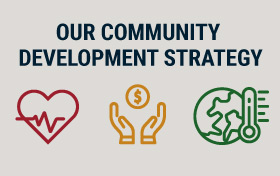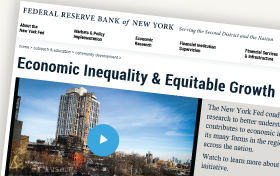What Quantity of Reserves Is Sufficient?
A concern of the Federal Reserve is how to manage its balance sheet and whether, over the long run, the balance sheet should be small or large. In this post, we highlight results from a recent paper in which we show how, even during a period of “ample” reserves, the Fed’s management of its balance sheet had material impacts on funding markets and especially the repo market. We argue that the Fed’s “balance-sheet normalization” from March 2017 to September 2019—under which aggregate reserves declined by more than $950 billion—combined with post-crisis liquidity regulations, stressed the intraday management of reserves of large bank holding companies that are active in wholesale funding markets resulting in higher repo rates and spikes in such.
The Spillover Effects of COVID‑19 on Productivity throughout the Supply Chain

While the shocks from COVID-19 were concentrated in a handful of contact-intensive industries, they had rippling effects throughout the economy, which culminated in a considerable decline in U.S. GDP. In this post, we estimate how much of the fall in U.S. GDP during the pandemic was driven by spillover effects from the productivity losses of contact-intensive industries.
The New York Fed DSGE Model Forecast—September 2021

This post presents an update of the economic forecasts generated by the Federal Reserve Bank of New York’s dynamic stochastic general equilibrium (DSGE) model. We describe very briefly our forecast and its change since June 2021.
Have Consumers’ Long‑Run Inflation Expectations Become Un‑Anchored?

With the recent surge in inflation since the spring there has been an increase in consumers’ short-run (one-year ahead) and, to a lesser extent, medium-run (three-year ahead) inflation expectations (see Survey of Consumer Expectations). Although this rise in short- and medium-run inflation expectations is relevant for policymakers, it does not provide direct evidence about “un-anchoring” of long-run inflation expectations. Roughly speaking, inflation expectations are considered un-anchored when long-run inflation expectations change significantly in response to developments in inflation or other economic variables, and begin to move away from levels consistent with the central bank’s (implicit or explicit) inflation objective. In that case, actual inflation can become unmoored and risks drifting persistently away from the central bank’s objective. Well-anchored long-run inflation expectations therefore represent an important measure of the success of monetary policy. In this post, we look at the current anchoring of consumers’ long-run inflation expectations using novel data from the Survey of Consumer Expectations (SCE). Our results suggest that in August 2021 consumers’ five-year ahead inflation expectations were as well anchored as they were two years ago, before the start of the pandemic.
Twenty Years After 9/11, New York City’s Resilience Is Tested Once Again

As we mourn the tragic losses of the 9/11 attacks twenty years on, we thought it would be appropriate to re-examine the remarkable resilience New York City’s economy has shown over the years—a resilience that is once again being tested by the ongoing COVID-19 pandemic. In this Liberty Street Economics post, we look at how Lower Manhattan, in particular, has changed since that tragedy on a number of dimensions, and use that as a framework to think about how the city might change as a result of the COVID pandemic.
If Prices Fall, Mortgage Foreclosures Will Rise

In our previous post, we illustrated the recent extraordinarily strong growth in home prices and explored some of its key spatial patterns. Such price increases remind many of the first decade of the 2000s when home prices reversed, contributing to a broad housing market collapse that led to a wave of foreclosures, a financial crisis, and a prolonged recession. This post explores the risk that such an event could recur if home prices go into reverse now. We find that although the situation looks superficially similar to the brink of the last crisis, there are important differences that are likely to mitigate the risks emanating from the housing sector.
Does the Rise in Housing Prices Suggest a Housing Bubble?

House prices have risen rapidly during the pandemic, increasing even faster than the pace set before the 2007 financial crisis and subsequent recession. Is there a risk that another dangerous housing bubble is developing? This is a complicated question, and the answer has many components. This post, the first of two, provides a more detailed look at the recent rise in home prices by breaking it down geographically, with a comparison to the pre-2007 bubble. The second post looks at the potential risks to financial stability by comparing the currently outstanding stock of mortgage debt to the period before the financial crisis and projecting defaults should prices decline.
The Housing Boom and the Decline in Mortgage Rates

During the pandemic, national home values and housing activity soared as mortgage rates declined to historic lows. Under the canonical “user cost” house price model, home values are held to be very sensitive to interest rates, especially at low interest rate levels. A calibration of this model can account for the house price boom with the observed decline in interest rates. But empirically, we find that home values are nowhere near as sensitive to interest rates as the user cost model predicts. This lower sensitivity is also found in prior economic research. Thus, the historical experience suggests that lower interest rates can only account for a tiny fraction of the pandemic house price boom. Instead, we find more scope for lower interest rates to explain the rise in housing activity, both sales and construction.
Going with the Flow: Changes in Banks’ Business Model and Performance Implications

Does the performance of banks improve or worsen when banks enter into new business activities? And does it matter which activities a bank expands into, or retreats from, and when that decision is made? These important questions have remained unaddressed due to a lack of data. In a recent publication, we used a unique data set detailing the organizational structure of the entire population of U.S. bank holding companies (BHCs). In this post, we draw on that research to show that while scope expansion on average hurts performance, entering into activities that are highly synergistic with core banking at a given point in time yields net performance benefits.














 RSS Feed
RSS Feed Follow Liberty Street Economics
Follow Liberty Street Economics